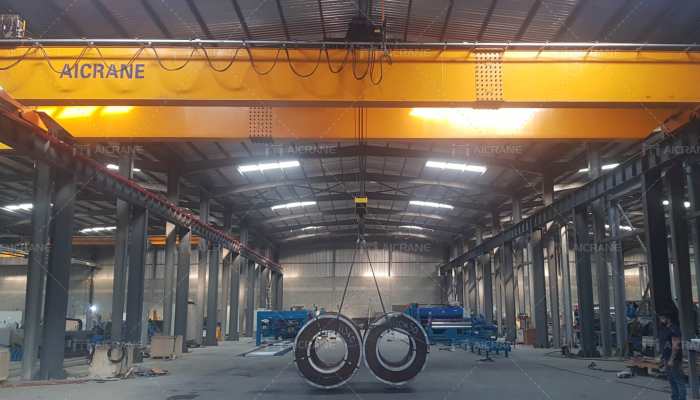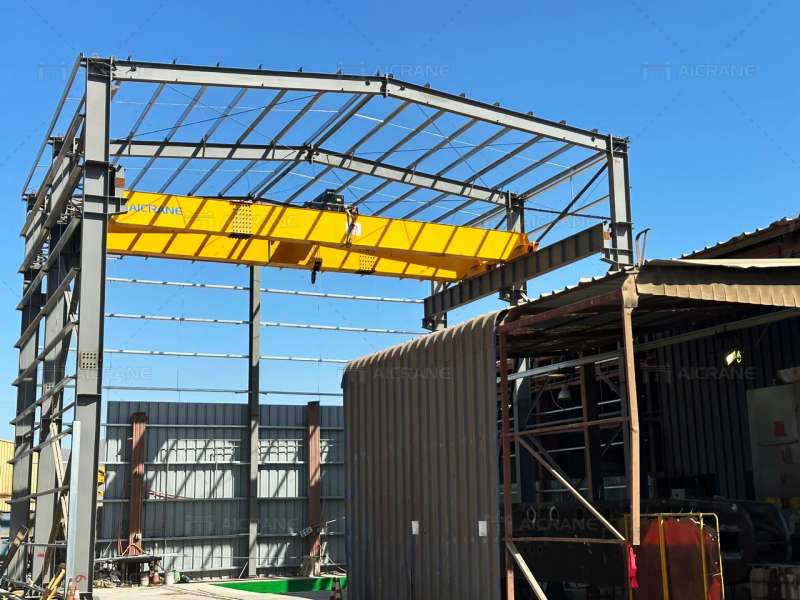When planning for any construction or manufacturing operation, budgeting is crucial. One of the significant investments many businesses make in industrial settings is the acquisition of a bridge crane. These machines are essential for lifting and moving heavy loads, making them invaluable in manufacturing plants, workshops, warehouses, and other industrial settings. However, understanding the bridge crane cost and how it fits into your overall budget is critical for effective financial planning and forecasting. This article will explore how the bridge crane cost can impact your budget, with a focus on planning for different types of overhead cranes, including hoist overhead cranes, workshop overhead cranes, and indoor overhead cranes.
What is a Bridge Crane?
A bridge crane, commonly known as an overhead crane, is a type of lifting device used to move heavy materials across a factory, workshop, or warehouse floor. The crane consists of a bridge (the main horizontal structure), which is supported by runways at either end. The hoist runs along the bridge to move loads efficiently. These cranes come in various configurations and lifting capacities to suit different industrial applications, from hoist overhead cranes that provide precise lifting for smaller loads, to workshop overhead cranes designed for use in heavy-duty environments.
When estimating the cost of a bridge crane, factors like lifting capacity, type of crane, operational features, installation requirements, and maintenance should be considered.

Factors Affecting Bridge Crane Cost
Several factors can influence the cost of a bridge crane, and understanding these elements can help you plan and forecast your budget more accurately. The following are the primary factors to consider:
1. Type of Overhead Crane: Hoist, Workshop, or Indoor
- Hoist Overhead Cranes
A hoist overhead crane is generally smaller, with a lower lifting capacity compared to larger industrial cranes. These cranes are ideal for operations that require precision and the ability to lift lighter to medium loads, such as in warehouses or for small-scale manufacturing projects. Since hoist overhead cranes are compact and have fewer moving parts, they are more cost-effective than heavier-duty cranes. They are typically less expensive upfront but still provide excellent performance for light to medium applications. - Workshop Overhead Cranes
Workshop overhead cranes are designed for use in more demanding environments where heavier materials need to be lifted frequently. These cranes are often custom-designed for specific industrial applications and can handle larger loads, sometimes reaching up to 100 tons or more. Because of their larger size and higher lifting capacity, workshop overhead cranes can be significantly more expensive than smaller hoist cranes. Additionally, the installation and maintenance costs for these cranes are higher due to their more complex designs and more extensive power and control systems. - Indoor Overhead Cranes
Indoor overhead cranes are typically used in enclosed spaces such as factories, warehouses, and industrial plants. These cranes are usually designed with specific space constraints in mind. Since they are built to operate in confined environments, they may feature lower lifting capacities and smaller dimensions compared to outdoor cranes. However, the cost of indoor overhead cranes can vary widely depending on their features, such as the automation of the lifting process or integration with other equipment like conveyors or production lines.
2. Lifting Capacity
The lifting capacity of the crane is a crucial factor in determining the overall cost. A higher lifting capacity usually means a higher cost due to the need for more robust materials, larger hoists, and more powerful motors. For example, a 50 ton bridge crane will naturally be more expensive than a 10 ton overhead crane, as the components involved need to be able to support heavier loads. It is essential to consider the type of work you need the crane to perform and ensure the lifting capacity matches your operational requirements. Overestimating the required capacity can lead to unnecessary costs, while underestimating it can lead to performance issues and unsafe operations.
3. Features and Customization
Modern overhead cranes come with many advanced features, including automation, remote control systems, real-time monitoring, and safety mechanisms such as anti-collision systems and load-sensing technology. The more advanced the features, the higher the crane’s cost. Customization also plays a significant role in pricing, as cranes designed to fit specific environmental conditions, such as high temperatures or extreme humidity, may cost more. These features improve operational efficiency, safety, and longevity, making them worthwhile investments in the long run.
4. Installation and Maintenance Costs
The cost of installing a bridge crane can vary significantly based on factors such as the complexity of the installation, the size of the crane, and the layout of the building. The installation process often includes foundation work, electrical wiring, and ensuring proper alignment, which can add to the overall cost. Similarly, the ongoing maintenance costs are another important consideration. Heavy-duty overhead cranes, especially those used in harsh environments or for lifting very heavy loads, will likely require more frequent maintenance, including lubrication, part replacements, and inspections. The cost of maintenance is a long-term consideration that should be factored into your overall budgeting and forecasting.

How Bridge Crane Cost Impacts Your Budget
The cost of acquiring and maintaining a bridge crane can significantly impact your industrial budget, especially for businesses operating on tight margins. Here’s how these costs can affect your financial planning:
1. Upfront Investment vs. Long-Term ROI
While the initial cost of a bridge crane (whether a hoist overhead crane, workshop overhead crane, or indoor overhead crane) can be substantial, it’s important to consider the long-term return on investment (ROI). Cranes that improve efficiency, reduce manual labor, and enhance safety can result in significant cost savings over time. For example, hoist overhead cranes may be ideal for lighter tasks and more frequent lifts, making them a cost-effective solution for small businesses or warehouses. On the other hand, investing in a workshop overhead crane may be necessary for heavy industries, where high lifting capacities and long-term reliability are critical.
2. Budget Forecasting for Maintenance and Repairs
When budgeting for a bridge crane, it’s important to factor in maintenance and repair costs. Regular maintenance, such as checking the lifting mechanisms, inspecting hoists, and replacing worn-out parts, is essential for keeping the crane in optimal working condition. Delayed maintenance can lead to costly breakdowns and potentially hazardous situations. Setting aside a portion of the budget for ongoing maintenance ensures that the crane continues to operate smoothly and lasts longer.
3. Impact on Operational Costs
By improving material handling, reducing labor costs, and increasing efficiency, bridge cranes help lower operational costs in the long run. For businesses with significant material handling needs, investing in a high-quality crane can increase overall efficiency, reduce downtime, and improve throughput, ultimately providing a favorable return on investment.
Conclusion
The cost of a bridge crane plays a significant role in industrial budgeting and forecasting. Whether you’re looking for a hoist overhead crane, a workshop overhead crane, or an indoor overhead crane, understanding the various factors that influence the price, such as lifting capacity, customization, and maintenance costs, is critical for making an informed decision.
While the initial investment in a bridge crane can be substantial, the long-term benefits—improved safety, increased efficiency, and reduced labor costs—make it a valuable investment for many industrial operations. Partnering with reputable overhead crane manufacturers ensures that you get the best value for your investment, with high-quality equipment designed to meet your specific operational needs and budget. Proper planning and forecasting for both the initial cost and ongoing maintenance will help businesses manage their finances effectively and ensure the smooth running of operations for years to come.